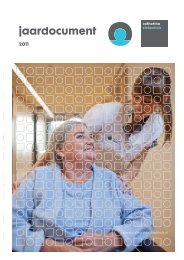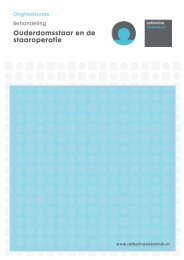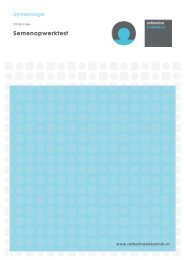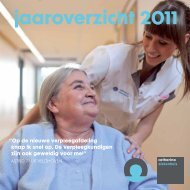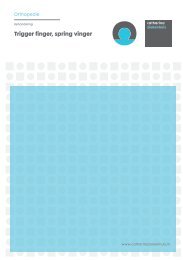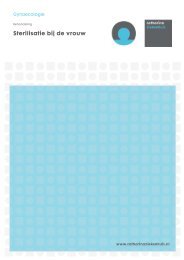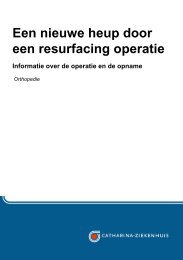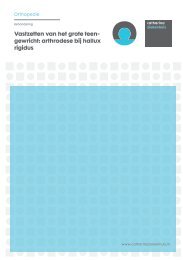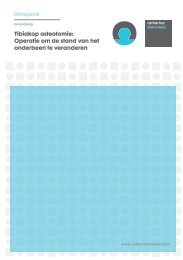Wetenschappelijk jaaroverzicht 2012 - Catharina Ziekenhuis
Wetenschappelijk jaaroverzicht 2012 - Catharina Ziekenhuis
Wetenschappelijk jaaroverzicht 2012 - Catharina Ziekenhuis
You also want an ePaper? Increase the reach of your titles
YUMPU automatically turns print PDFs into web optimized ePapers that Google loves.
evaluated. Overall, 26 patients underwent the vasomotion test (18 at 12 and 8 at 24<br />
months). Vasodilatory response to Ach was quantitatively associated with larger reductions<br />
over time in polymeric strut echogenicity (y= -0.159x- 6.85; r= -0.781, P< 0.001). Scaffolded<br />
segments with vasoconstriction to Ach had larger vessel areas (14.37 ± 2.50 vs. 11.85 ± 2.54<br />
mm(2), P= 0.030), larger plaque burden (57.31 ± 5.96 vs. 49.09 ± 9.10%, P= 0.018), and larger<br />
necrotic core (NC) areas [1.39 (+1.14, +1.74) vs. 0.78 mm(2) (+0.20, +0.98), P= 0.006]<br />
compared with those with vasodilation.<br />
CONCLUSION: Vasodilatory response to Ach, in coronary segments scaffolded by the<br />
ABSORB BVS device, is associated with a reduction in echogenicity of the scaffold over time,<br />
and a low amount of NC. In particular, the latter finding resembles the behaviour of a native<br />
coronary artery not caged by an intracoronary device.<br />
Impactfactor: 10.478<br />
Koolen JJ<br />
First serial assessment at 6 months and 2 years of the second generation of absorb<br />
everolimus-eluting bioresorbable vascular scaffold: a multi-imaging modality study<br />
Ormiston JA, Serruys PW, Onuma Y, Geuns RJ van, Bruyne B de, Dudek D, Thuesen L,<br />
Smits PC, Chevalier B, McClean D, Koolen J*, Windecker S, Whitbourn R, Meredith I,<br />
Dorange C, Veldhof S, Hebert KM, Rapoza R, Garcia-Garcia HM<br />
Circ Cardiovasc Interv. <strong>2012</strong> Oct 1;5(5):620-32<br />
BACKGROUND: Nonserial observations have shown this bioresorbable scaffold to have no<br />
signs of area reduction at 6 months and recovery of vasomotion at 1 year. Serial<br />
observations at 6 months and 2 years have to confirm the absence of late restenosis or<br />
unfavorable imaging outcomes.<br />
METHODS AND RESULTS: The ABSORB trial is a multicenter single-arm trial assessing the<br />
safety and performance of an everolimus-eluting bioresorbable vascular scaffold. Forty-five<br />
patients underwent serial invasive imaging, such as quantitative coronary angiography,<br />
intravascular ultrasound, and optical coherence tomography at 6 and 24 months of followup.<br />
From 6 to 24 months, late luminal loss increased from 0.16±0.18 to 0.27±0.20 mm on<br />
quantitative coronary angiography, with an increase in neointima of 0.68±0.43 mm(2) on<br />
optical coherence tomography and 0.17±0.26 mm(2) on intravascular ultrasound. Struts still<br />
recognizable on optical coherence tomography at 2 years showed 99% of neointimal<br />
coverage with optical and ultrasonic signs of bioresorption accompanied by increase in mean<br />
scaffold area compared with baseline (0.54±1.09 mm(2) on intravascular ultrasound,<br />
P=0.003 and 0.77 ±1.33 m(2) on optical coherence tomography, P=0.016). Two-year major<br />
adverse cardiac event rate was 6.8% without any scaffold thrombosis.<br />
CONCLUSIONS: This serial analysis of the second generation of the everolimus-eluting<br />
bioresorbable vascular scaffold confirmed, at medium term, the safety and efficacy of the<br />
new device. CLINICAL TRIAL REGISTRATION: URL: http://www.clinicaltrials.gov. Unique<br />
identifier: NCT00856856.<br />
Impactfactor: 6.058<br />
41



